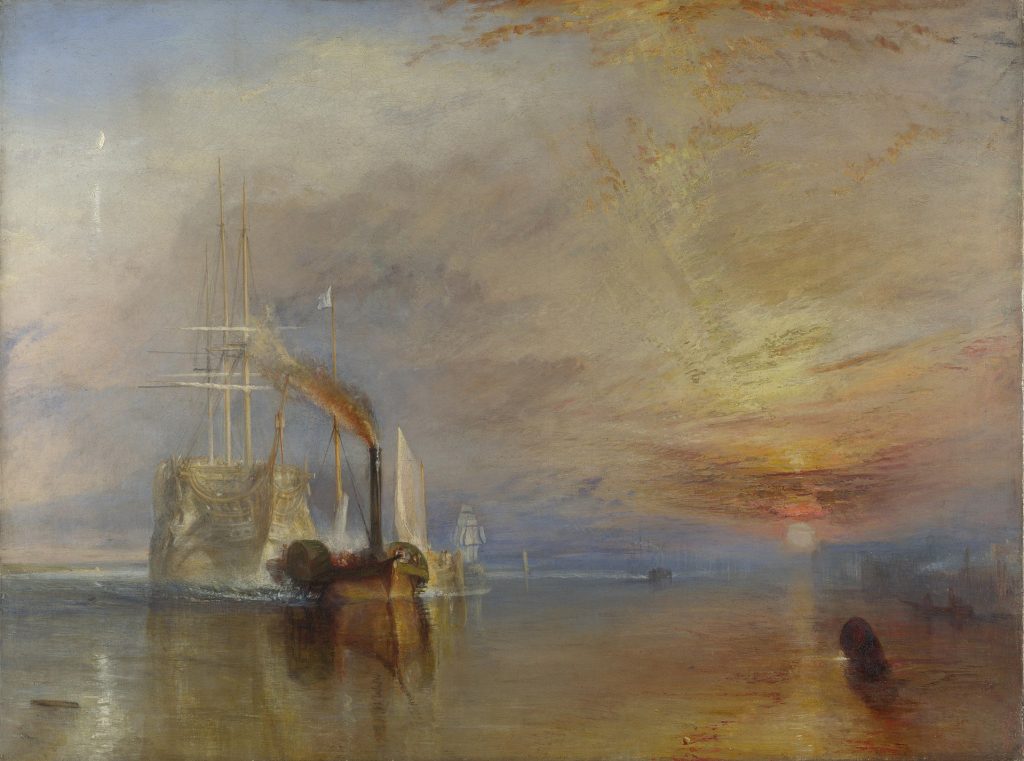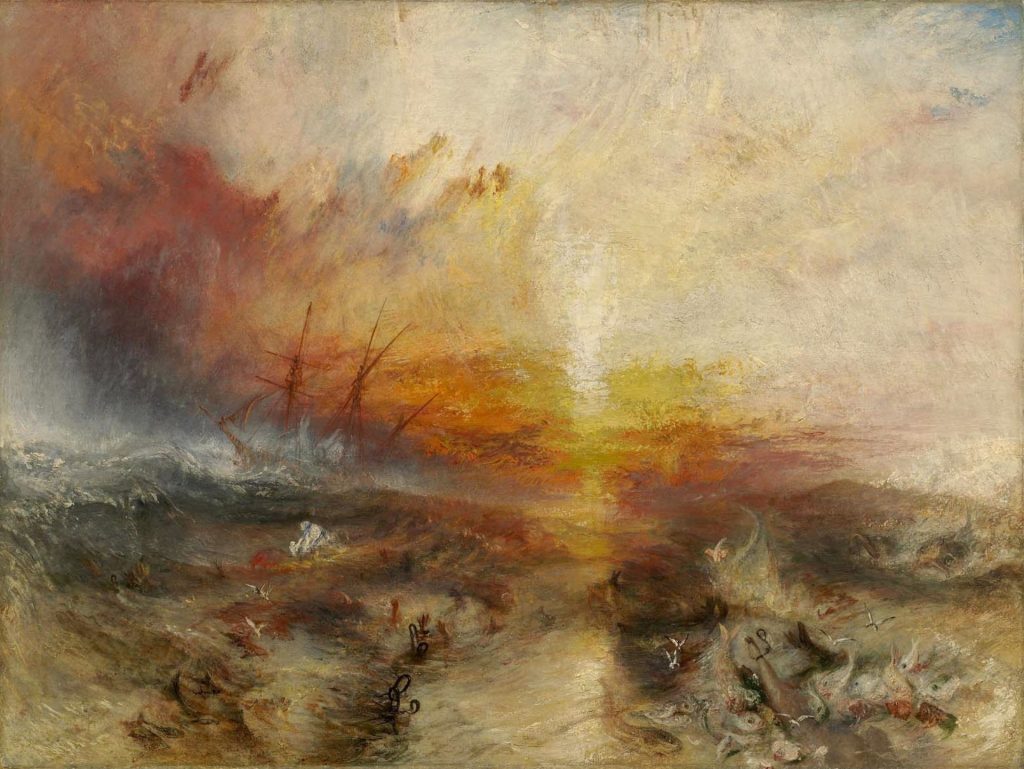10 Chapter 7 – J. M. W. Turner
Through My Fault
Hannah Hicks
Audio recording of chapter available here:

Joseph William Mallord Turner was an artist who was known as “A true professional, he never stopped observing, recording.”[1] He is best known for his many seascapes that seem to capture both the calm peaceful days and the storms that can come out of nowhere. He is also known to challenge those who observe and examine his artwork, especially through his given titles.[2] In 1840 Turner exhibited The Slave Ship at The Royal Academy of Arts, where it was met with an overall negative response. The painting is thought to be pointing at the moral failings of those involved in and who benefited from the slave trade, and therefore points the finger at them. However, there is evidence that Turner himself had been part of an investment scheme with slave labor providing the profits. Therefore, The Slave Ship wasn’t just a finger pointing response at those who thrived from the slave trade, rather it was Turner’s personal atonement for the sins of his past.

The full title of this painting is Slavers Throwing Overboard the Dead and Dying- Typhoon Coming On. It was painted with oil on canvas in 1840.[3] The scene shows a ship in the background, facing an oncoming typhoon. As you start to look at the waves in the foreground, you see arms and legs sinking into the watery depths, some have what look to be rope or chains around them. All of this is depicted with vibrant colors and bold brush strokes to match the intensity of the scene. It depicts the story of why the slave-ship Zong threw slaves overboard who were either dead or dying in 1783 to profit from an insurance scam. To collect the insurance money, slaves had to have been “lost at sea”, otherwise the owners couldn’t collect the money if they succumbed to diseases.[4] Accompanying the painting was a verse from Turner’s poem Fallacies of Hope that seemed to point blame at those who dared to profit from slavery. However, as we start examining Turners past dealings, we wonder if this was more of a self-reflection on his past decisions.
In terms of the opinion of the slave trade in the 1820’s, Turner was aligned with the public majority that supported abolishment.[5] But it was a different story back in 1805 with an investment into a Jamaican speculation that profited directly from slave labor.[6] This was in the form of a tontine, an investment scheme that would see the survivors’ annuities increase when one of the members die.[7] The younger you were, the more you stood to gain from this investment; despite being thirty-one years old, Turner could expect a fifteen percent return which would cover what he invested and still gain a moderate profit.[8] Turner knew where and how this profit would come, mainly because The Proposals, that he would have to have read, referred to the people enslaved as “chattel” many times over and how to buy and sell them as well.[9] How Turner came to know about this investment is up for debate, but the most likely situation is that he was recommended by a client of his out of appreciation for his work.[10] However, at the time of this investment a historic moment was unfolding; the abolition of the slave trade was a few years out from victory.[11] In the following years the Anti-Slavers Society campaigned hard for changes and to educate those around them; one of them would be Turner who most likely started to support the abolitionists in the 1820’s.[12] This would start to influence his art and he would go on to paint The Slave Ship in 1840.
In terms of the public reception of this painting, most responses were dripping with distain. Questions such as “What was there to admire in this painting?”[13] or “Is this picture sublime or ridiculous?”[14] were asked. Someone even exclaimed that the statue of Wilberforce located downstairs of the painting “-would spring off his chair and fly away in terror!”[15] if it even caught sight of Turners painting. Overall, Slavers Throwing Overboard the Dead and Dying- Typhoon Coming On received harsh criticism; partly because the British public didn’t want to be reminded about the atrocities they helped and encouraged with the slave trade, and partly because it challenged their perception of this gruesome past. The following quote best explains the harsh push back of Turner’s painting; “To accept Turner’s titles as part of his paintings was to accept this disturbing readjustment of one’s relationship to art and nature. Neither was a static system and neither could be controlled.”[16] The public didn’t want their perspectives challenged; but because of the title that accompanied this painting, they had to acknowledge the disturbing truth of the past. Turner further drives this point home with the following verse from his incomplete long poem Fallacies of Hope:
“Aloft all hands, strike the top-masts and belay;
Yon angry setting sun and fierce-edged clouds
Declare the Typhoon’s coming.
Before it sweeps your decks, throw overboard
The dead and dying – ne’er heed their chains
Hope, Hope, fallacious Hope!
Where is thy market now?”[17]
At first it seems that Turner is pointing at those who directly benefited and prospered from the abominations that they committed during the slave trade; but with the knowledge of Turner’s actions and involvement of the slave trade it becomes a lament of past decisions through a mea culpa.[18]
It’s easy to point fingers at those who participated in the slave trade and judge them as morally corrupt. However, we must remember that this was just part of the everyday for most people in the 1700-1800’s. As well, it would have been incredibly hard for anyone to do any sort of business with people who had zero ties to the slave trade, artists especially.[19] Turner was no exception to this, but he did change his opinion and share it with the world around him; despite knowing he wouldn’t be properly appreciated in his time.[20] There is no doubt that The Slave Ship sheds light on those who morally corrupted themselves with it’s dark dealings, but there is also no doubt that this painting was Turner’s personal reminder of his ethical shortcomings and his attempt to atone for it.[21]
Bibliography
Fisher, Judith L. “Magnificent or Mad? Nineteenth-Century Periodicals and the Paintings of Joseph Mallord William Turner.” Victorian Periodicals Review 29, no. 3 (1996): 242–60. http://www.jstor.org/stable/20082926.
Hunt, John Dixon. “Turner and Landscape Painting: Remarks, Aspects, Glosses.” The Eighteenth Century 20, no. 3 (1979): 260–76. http://www.jstor.org/stable/41467199.
“Slave Ship (Slavers Throwing Overboard the Dead and Dying – Typhoon Coming On)”. An Introduction to Nineteenth Century Art. Accessed, November 8, 2023 https://www.19thcenturyart-facos.com/artwork/slave-ship-slavers-throwing-overboard-dead-and-dying-–-typhoon-coming
Smiles, Sam. “Turner and the Slave Trade: Speculation and Representation, 1805-40.” The British Art Journal 8, no. 3 (2007): 47–54. http://www.jstor.org/stable/41614774.
Tate Gallery. “Turner”. London: The Tate Gallery Publications Department, 1974.
Walker, Andrew. “From Private Sermon to Public Masterpiece: J. M. W. Turner’s ‘The Slave Ship’ in Boston, 1876-1899.” Journal of the Museum of Fine Arts, Boston 6 (1994): 4–13. http://www.jstor.org/stable/20519760.
Wilkinson, Gerald. Turner’s Early Sketchbooks. New York: Watson-Guptill Publications, 1972.
- Monnington, Sir Thomaas. “Turner”. The Tate Gallery Publications Department, Millbank London. 1974. Pg 10 ↵
- Hunt, John Dixon. “TURNER AND LANDSCAPE PAINTING: REMARKS, ASPECTS, GLOSSES.” The Eighteenth Century 20, no. 3 (1979): 260–76. http://www.jstor.org/stable/41467199. Pg. 288 ↵
- Tate Gallery. “Turner”. The Tate Gallery Publications Department, Millbank London. 1974. Pg. 144 ↵
- Tate. “Turner”. Pg. 145 ↵
- Smiles, Sam. “Turner and the Slave Trade: Speculation and Representation, 1805-40.” The British Art Journal 8, no. 3 (2007): 47–54. http://www.jstor.org/stable/41614774. Pg. 47 ↵
- Smiles. “Turner and the Slave Trade: Speculation and Representation, 1805-40.” Pg. 47 ↵
- Smiles. “Turner and the Slave Trade: Speculation and Representation, 1805-40.” Pg. 47 ↵
- Smiles, Sam. “Turner and the Slave Trade: Speculation and Representation, 1805-40.” The British Art Journal 8, no. 3 (2007): 47–54. http://www.jstor.org/stable/41614774. Pg. 48 ↵
- Smiles. “Turner and the Slave Trade: Speculation and Representation, 1805-40.” Pg. 48 ↵
- Smiles. “Turner and the Slave Trade: Speculation and Representation, 1805-40.” Pg. 49 ↵
- Smiles. “Turner and the Slave Trade: Speculation and Representation, 1805-40.” Pg. 50 ↵
- Smiles. “Turner and the Slave Trade: Speculation and Representation, 1805-40.” Pg. 52 ↵
- Walker, Andrew. “From Private Sermon to Public Masterpiece: J. M. W. Turner’s ‘The Slave Ship’ in Boston, 1876-1899.” Journal of the Museum of Fine Arts, Boston 6 (1994): 4–13. http://www.jstor.org/stable/20519760. Pg. 9 ↵
- Tate Gallery. “Turner”. The Tate Gallery Publications Department, Millbank London. 1974. Pg 145 ↵
- Tate. “Turner”. Pg. 145 ↵
- Fisher, Judith L. “Magnificent or Mad? Nineteenth-Century Periodicals and the Paintings of Joseph Mallord William Turner.” Victorian Periodicals Review 29, no. 3 (1996): 242–60. http://www.jstor.org/stable/20082926. Pg. 256 ↵
- “Slave Ship (Slavers Throwing Overboard the Dead and Dying – Typhoon Coming On)”. An Introduction to Nineteenth Century Art. Accessed, November 8, 2023 https://www.19thcenturyart-facos.com/artwork/slave-ship-slavers-throwing-overboard-dead-and-dying-–-typhoon-coming ↵
- Mea Culpa: Latin for “through my fault”. A formal acknowledgment of personal fault. Mea culpa Definition & Meaning - Merriam-Webster ↵
- Smiles, Sam. “Turner and the Slave Trade: Speculation and Representation, 1805-40.” The British Art Journal 8, no. 3 (2007): 47–54. http://www.jstor.org/stable/41614774. Pg. 51 ↵
- Wilkinson, Gerald. “Turner’s early sketchbooks.” Watson-Guptill Publications 165 West 46 Street, New York. 1972. Pg. 12 ↵
- Smiles, Sam. “Turner and the Slave Trade: Speculation and Representation, 1805-40.” The British Art Journal 8, no. 3 (2007): 47–54. http://www.jstor.org/stable/41614774. Pg. 53 ↵

